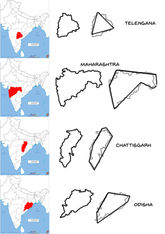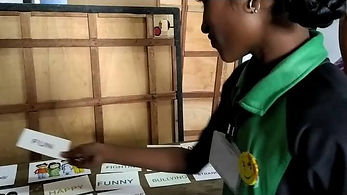1.Chok - A - Block
An educational tool that facilitates an inclusive model of learning for children aged 10-13 years.

A4 book with a box of wooden coloured blocks Created for
the PreThesis Project at
Srishti Institute of Art Design and Technology
August - December 2021
The Problem
Research shows that by the age of 14, children start forming an aversion to one or more subjects. They start finding school boring, difficult or unnecessary.
How might we create fun, playful and creative ways of information dissemination, that makes the learning process more inclusive, and prevents the loss of confidence and motivation amongst middle-school children?
Effective learning methods like regular recalling and retrieving of information forms the basis of the curriculum. This aide involves a strong focus on the understanding of concepts, that will automatically lead to better test attempts and school performance.
Children who use Chok-A-Block find learning more playful, engaging, and approachable, thus breaking the barriers of the structure of conventional education models.
The Impact
The Solution
Chok a Block is a tactile way of learning concepts for classes 5 to 7 (Using a set of blocks provided) that caters to all kinds of learners - visual, audito ry, verbal and kinesthetic.
Chok a Block promotes a slow learning process - no time constraints, no tests, if you do not un derstand something, go back and re-read. with several tools that will support the learner through their journey.

Month 3
Month 2
User Testing Round 1
Ideation Round 1
Ideation Round 2
Final Development
User Testing Round 2
Secondary Research : Educational Philosophies Cognitive development Effective learning practises
Market Research : What has already been done?
Primary Research : Children Primary School Teachers Parents Creative education specialists
Month 1
My process

An iterative process
The process that went into arriving at the final design for the blocks and manual was an iterative one. Working with children instead of for them, allows one to cater to their needs, take in their feedback, and create a design that serves them. From iteration 1 (left top) to iteration 5 (bottom right), several edits were created, to make the blocks as universal as possible.
Through this project, children took on the role of information leaders, guiding the iterative process, while the designers role was to come up with newer ideas that could serve them better.
_edited.png)
2.Project Relay
An education revolution that prioritizes inclusivity and security, during the ongoing pandemic.
Website design
Created for an examination at Srishti Institute of Art Designand Technology January 2021


The Problem
The pandemic has brought about a tipping point in education, with schools switching to digital modes of teaching entirely. This makes more clear, the digital divide in India, rendering millions of children education-less, not to mention hungry and poverty stricken.
How might we create a system that ensures continued learning even for the children without internet access

The Solution
Project Relay is a proposal to create systemic change in the way education during the pandemic is handled, within the area of Mylapore, Chennai. The areas addressed under Project Relay are
-
Education
-
System design, curriculum design
-
Nutrition
-
Healthcare
The Framework
The people
Project Relay is run by volunteers aged 18 and older, who not only develop the curriculum but also facilitate activities for children in the field. The children are grouped into batches based on their age and the days of the week, with one volunteer typically handling around 36 children at a time. On their designated days, the children come to the Anganwadi to receive educational materials, nutritional support, and healthcare assistance.
The curriculum
Project Relay aims at combining academics with socio emotional learning, to help children cope with the pandemic situation. Volunteers combine lessons with these activities, and convert them into audio pods that can be distributed to children through low-tech phones, without the need for high speed internet, during their time in the Anganwadi.
The Space
Project Relay proposes an addition of 32 new Anganwadis in the Mylapore area, to ensure equal distribution and access for children. With the addition of these spaces, children can be seated keeping in mind social distancing rules and safety protocol. The building of these Anganwadis will be supported by the GOI that released 29,165 crores for the Anganwadi project in 2019-20.
Nutrition and Healthcare
Project Relay aims at partnering with NGO’s that work with child nutrition and healthcare to provide a safe environment for the child's holistic growth. In contrast, Project Relay works on education internally. Within the Anganwadi, there will be meals distributed, and a doctor at stand by. This system has been created because at Project Relay, we believe that no child can focus on their education if their basic nneeds arenot mett.

3.Safety for Kids
An parental workshop kit that creates awareness about childrens safety.


Workshop design
Created for a studio project at
Srishti Institute of Art Design and Technology September 2019
The Problem
Research shows that parents views about child safety often does not align with their childrens views about the same. In an urban setting, there are several incidents that take place, which seem harmless to parents, but might be uncomfortable for their children. This could cause serious mental health issues amongst children. Moreover, in a semi urban setting, the physical safety of children if often compromised due to negligence, simply because the parents are busy making ends meet to truly provide and create a safe space for their children.
The Solution
Safety for kids is a two-part parental workshop toolkit that enables parents to have conversations about childrens safety, by directly engaging with childrens views about the same. This toolkit puts the children in the position of an information leader, hence making our output user-driven. Urban and semi-urban families face drastically different challenges when it comes to childrens safety, and hence two seperate toolkits were designed for the two demographics, to cater to the special needs of each of them.





The Impact
After engaging with the safety for kids toolkit, urban parents realised that their children are intuitive enough to understand when a comment/touch is made in good intentions and otherwise. They also agreed that it is the right of the child to decide what they are comfortable with, and it is the responsibility of the parent to draw clear boundaries that will honour their choice.
Semi urban parents, upon engaging with the toolkit gained several insights on what their children associate with emotions such as happiness, anger, excitement and sadness. They also understood that theur children associate some spaces with safety and some with danger. This toolkit served as a way to open up dialogue about the issue of safety with the parents, and they realised that open communication with their children about these issues, is key to a healthy upbringing.
The Process
Design Tools: Directed storytelling allows the designer to gather rich stories of lived experiences from participants, using thoughtful prompts and guiding questions in the conversation. This was achieved using picture cards that contain words and images that help people think about and tell true stories of their life experiences, grounded in context and detail.







